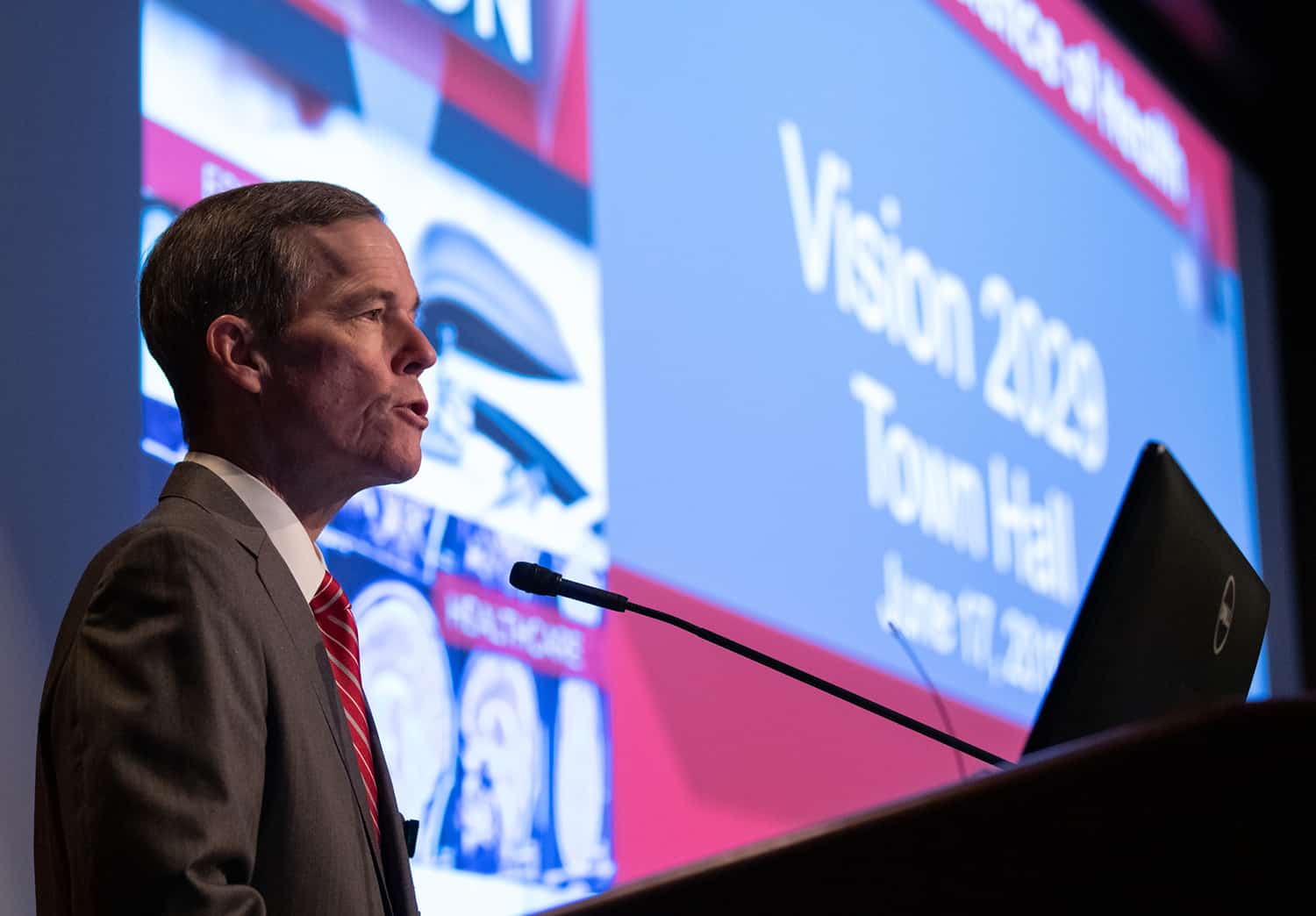Review Phase of ‘Ambitious’ 2029 Strategic Plan Nears End
| After more than a month collecting feedback and reactions to the draft 10-year Vision 2029 strategic plan, UAMS is nearing the point where it will finalize the plan and shift to implementation, said Stephanie Gardner, Pharm.D., Ed.D., provost and chief strategy officer, during a June 17 town hall update.
Posted to the intranet on May 3, the 55-page draft plan details a set of strategic objectives across its mission areas, along with measurements identified to demonstrate progress and proposed initiatives to achieve those benchmarks. The overarching vision is, “By 2029, the University of Arkansas for Medical Sciences (UAMS) will lead Arkansas to be the healthiest state in the region through its synergies of education, clinical care, research, and purposeful leadership.”
“It’s an ambitious plan. It holds us accountable,” said Chancellor Cam Patterson, M.D., M.B.A. “There is a lot to be excited about in the plan. I’m excited about the focus around digital health, around rural health and transforming UAMS into a truly statewide institution.”
When the draft plan was released, it was accompanied by a feedback survey on the intranet and an email address for employees to submit comments and suggestions. As of Friday, June 14, when the comment period ended, 232 employees took the survey, with 144 of those including comments to an open response question. More than 80 other emailed comments were submitted, some with multiple pages of feedback — including a few who followed the plan format with suggested objectives, outcome measurements and initiatives.

Faculty, staff and students at the town hall meeting listen as the Vision 2029 plan is presented. Photo credit, Bryan Clifton
In addition to electronic feedback, a series of four small group sessions were held to discuss the draft, answer questions and solicit feedback. More than 60 employees signed up for those sessions, Gardner said, where the discussion was “lively and wide open.”
Feedback on the plan will be categorized and vetted with the working groups from each area — clinical, education and research. Gardner said her goal is to finalize the plan with revisions by the end of June, then share widely as the effort moves to implementation. Going forward, there will be quarterly progress reports on the plan, along with annual reviews that will offer an opportunity to evaluate the objectives to determine any necessary revisions or updates, she said.
In the months ahead, she said, the Organizational Development team within the Office of Human Resources that has helped facilitate the Vision 2029 process will be available to meet with departments and programs across UAMS. The idea is that every unit at UAMS will create their own strategy map, the visual representation of strategic objectives that is the centerpiece of Vision 2029. In the process of creating their own strategy maps, units will identify the elements of the overall UAMS plan that align with their work, leading to their own objectives, outcome measures and initiatives.
“Ultimately, we hope that every member of Team UAMS will know how their day-to-day work contributes to success in the Vision 2029 plan — whether they are in a clinic, the hospital, a classroom, a lab, a regional center or wherever in Arkansas they are working,” Gardner said.
Opening the floor for comment, some commented positively on the comprehensiveness of the proposed plan and excitement about focuses on digital health and movement toward becoming a health system. Asked about gaps, there were suggestions in areas of cancer care and research to strengthen some objectives.
“This is a big, bold and hairy plan and overall it’s really exciting,” said James Marsh, M.D., chair of the Department of Internal Medicine in the College of Medicine. “I think the most exciting thing to me is shifting from being an academic health center to an academic health system. We have to do it.”
The overall UAMS strategy map included objectives for its stakeholders; in its clinical, education, and research mission areas; and financial objectives to ensure it remained a good steward of its resources. Also charted were objectives in three areas that crossed all of the others: partnerships, digital health, and talent and technology.
For its stakeholders — its patients, students and the state that it serves — UAMS pledged to:
- Establish a leadership role in all UAMS mission areas in Northwest Arkansas
- Improve the health and wellness of all Arkansans
- Improve health care quality and the patient experience at a lower cost
- Become the employer of choice
- Ensure a diverse workforce to meet the health care needs of Arkansans
While working toward those stakeholder objectives, UAMS also will:
- Deliver patient care at a level of quality and expertise that earns recognition from peers, accrediting and professional organizations, and the public
- Maximize innovation in health professions education while starting or expanding academic programs that meet workforce needs
- Promote research in areas of cancer research, interdisciplinary scholarship, translational research and work that fosters entrepreneurship
- Establish new or expand existing partnerships with organizations across the state to strengthen clinical, academic and research capacity
- Become a fully deployed digital health institution
- Recruit, develop, and retain a skilled, motivated and engaged workforce
